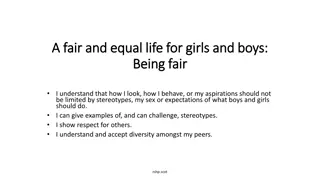Challenging Gender Stereotypes: Understanding, Reflecting, and Respecting Differences
Explore the impact of gender stereotyping on individuals and society, learn to recognize and challenge these stereotypes, and foster a culture of respect, equality, and understanding regardless of gender.
Download Presentation

Please find below an Image/Link to download the presentation.
The content on the website is provided AS IS for your information and personal use only. It may not be sold, licensed, or shared on other websites without obtaining consent from the author.If you encounter any issues during the download, it is possible that the publisher has removed the file from their server.
You are allowed to download the files provided on this website for personal or commercial use, subject to the condition that they are used lawfully. All files are the property of their respective owners.
The content on the website is provided AS IS for your information and personal use only. It may not be sold, licensed, or shared on other websites without obtaining consent from the author.
E N D
Presentation Transcript
Learning Objectives 1. Understand what gender stereotyping and the myths are Understand that gender stereotypes may limit the way people think and behave Learn to respect individual differences, including personality, to build up equal and respectful relationships with others, regardless of gender and not to judge other people on gender alone. 2. 3.
What kind of gender ideologies does this pictures represent
Activity: His or Hers? Discuss the followings: i. To individual members of the group, does he/she accept the gender/scenario combination? Why? ii. Is the gender/scenario combination generally accepted in our society? iii. Will the acceptance level significantly change if the gender in the combination changes? iv. Does the reason to accept or reject reflect the kinds of expectation and stereotypes towards males and females in our society?
Be a Homemaker and Take Care of children
Conclusions Gender stereotyping serves certain functions. For example, it may be a reference framework and one may learn how to be socially accepted by following those commonly accepted or stereotyped models. However, if one understands gender in a narrow and rigid way, regardless of individual uniqueness or social changes, inequity, limitation or even discrimination may result. Students are encouraged to reflect on their personal beliefs on gender. If there is less gender stereotyping and more autonomous options, people can develop their talent and capacity fully without being limited by gender inequality.























